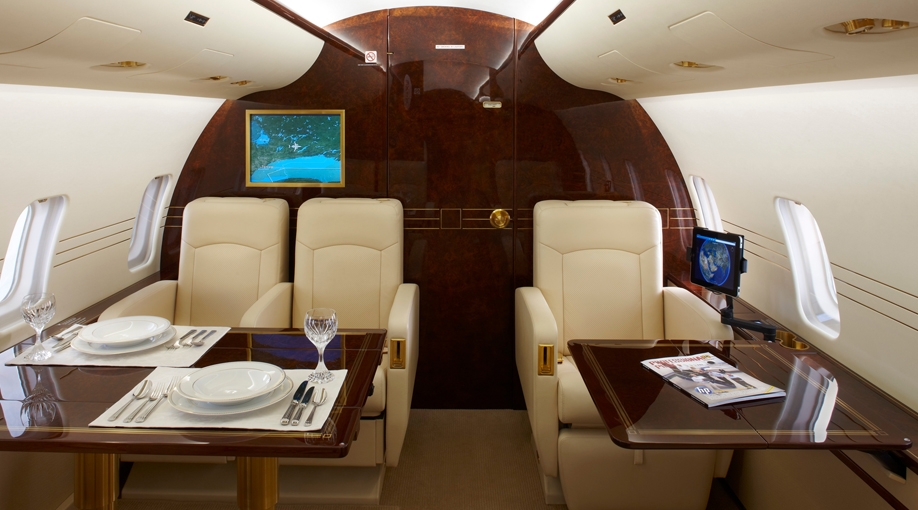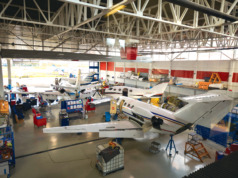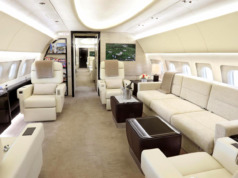
Is it time to refurbish or upgrade your aircraft? Start by making a key decision: are you going to keep it — and if so, for how long? — or sell it? If you plan to hold it for another five years, an upgrade or refurbishment will be primarily for your own benefit. If you plan on selling within the next year or two, carefully consider the options that will increase its value or make it more attractive for a quicker sale. Realize that if you design a unique interior or install expensive options, they may not add any substantial value to the aircraft.
According to John Spoor, President of Las Vegas-based SAI Valuations, “Upgrading and refurbishment definitely adds value to your aircraft; however it is not dollar for dollar.” Often, those who benefit from your upgrades are the secondary buyers. Spoor says it also matters what upgrades you make. For example, a state-of-the-art upgrade in voice and Internet connectivity can return as much as 80 cents on a dollar, whereas second stage upgrades, such as older technology analog cockpit instruments to flat panel screens, will not return as much value. He recommends considering these factors:
- Aircraft total time — if you want a replacement aircraft with less time on its airframe and engines (and so presumably less wear and tear), you’re likely to find one, given the current high inventory of pre-owned aircraft on the market.
- Any damage history to your aircraft is likely to have an impact on its value.
- How desirable is your aircraft’s airframe? Some aircraft are better suited to upgrade and refurbishment than others.
- Most aircraft owners now require the latest technology in the cabin, so a “connectivity” upgrade carries high desirability and higher value.
Refurbishment or Upgrade?
What is the difference between a refurbishment and an upgrade? A refurbishment is a simple change and can include a change in the colors, a new carpet, sidewalls and headliner (the soft goods), and new exterior paint. When complete, the refurbished aircraft will have essentially the same technology interior. But an extensive refurbishment may include a floor plan change, which likely will require a FAA recertification of the interior — undoubtedly raising the refurbishment cost significantly, in both time and money.
Or, you can upgrade the aircraft interior by adding options or enhancing the entertainment and communications suite. Your aircraft will benefit from incorporating some of the recent major technological advances in the cabin. While new technology exists in the avionics and engines, you as the owner will experience the direct benefits of upgraded cabin technology.
“Aircraft modernization or refurbishment projects can substantively improve an aircraft’s Asset Insight Index,” according to Tony Kioussis, President of Asset Insight, Inc., whose company grades the technical condition of business aircraft for owners, appraisers, and leasing firms. “How much an aircraft’s value improves will vary. While modernization projects can increase the price at time of sale, installation of passenger communication technology not yet available when the aircraft was manufactured can enhance ‘efficiency value’ for the current owner. Optimizing the cost vs. value equation usually comes down to how well the project is managed from the design phase forward.”
“For example,” Kioussis says, “the owner may wish to install a three-place divan in a certain position in the cabin. The designer can address the owner’s request, and the facility can install the divan per the designer’s drawings. However, once the owner starts operating the aircraft, he or she may be disappointed with the cabin ventilation system, because achieving the desired installation required an inefficient routing of air ducts. This is why hiring a full-time, independent, project management firm, experienced in aircraft completions, modernizations, and upgrades is critical in such projects. These firms more than pay for themselves.”
How to Begin
Prior to beginning any project of this magnitude, you should consider employing an outside company that has the capability to manage such a large undertaking. A competent program management firm will be able to keep you informed on the progress, and consult you promptly about important decisions you must make. The program management firm also will oversee the many experts who are involved in the process, including designers, quality inspectors, and technical managers.
They also will serve as your liaison to the modification center, as they will be based onsite to oversee the quality of the work, to ensure conformity to your specifications, and keep the project on schedule. Some owners prefer that their own flight department oversee operations. That may be feasible for smaller projects. But the specific expertise required to complete a full refurbishment to your satisfaction, on time and within budget, is usually found only in outside consultants who work with a variety of completion centers on a regular basis — not once every five or more years.
The primary (“Keep or Sell?”) decision affects every following decision. Since the cost of a refurbishment or upgrade can vary considerably — depending upon the design changes, options selected, and age of the aircraft — your expectations should be clearly defined at the outset. First you will define a detailed scope of work, including the floor plan design, desired options, any manufacturers’ service bulletins for product improvement you’d like added, or required inspections that need compliance. The more detailed the scope of work, the design, and the specification, the higher the chance that your expectations will be met.
Another factor is whether or not your aircraft is due for any detailed inspections. Since major modifications will require removing the interior of the aircraft, the best time to complete a major refurbishment or an upgrade is in conjunction with a major airframe inspection.
Expect to go through the cycle of comparing your aircraft’s inspection schedule with prospective modification requirements a few times before you finalize the scope of work and budget.
Once you have clearly defined the scope of work, you will select a completion center (or service center) to complete the work. Selection of a capable center should be based on a number of factors (see sidebar above).
Once selected, the center will perform an incoming intake inspection, and then order the required parts. Ideally, the completion crew would have all the parts and materials on hand, then work steadily until the project is completed and inspected. But that doesn’t always happen. Many custom components and materials have very long lead times, so proper planning and materials ordering will expedite your project.
The Three Project Components
Scheduling the work, including ordering parts and materials, is only one of the three main components that must be managed before any refurbishing or upgrade project can begin, the other two being quality and cost. Ideally, each component will complement the others in a timely and efficient way. But not all customers have the same priorities.
Some owners want the very highest quality, with no consideration to cost or project completion time. Others will forego possible upgrades that are likely to result in undue schedule delays. The formula for successful completion varies from owner to owner.
While routine maintenance helps preserve your aircraft’s day-to-day utility as a business tool, preserving its asset value requires periodic refurbishment and upgrades — and those require careful, specific planning, oversight, and execution. BAA
Choosing an Aircraft Completion Center
- Does it have the capability, experience, and capacity to work on your aircraft?
- Is it approved by the Original Equipment Manufacturer (OEM) to work on your type of aircraft? Is it an FAA-approved repair center?
- Does it have a reputation for doing the highest-quality work? Will it show you examples?
- Where is it located? Does it have state-of-the-art facilities?
- Is there a good working relationship between the work force and the management?
- Will you or your representative have the ability to see the progress of the build any time you want?
Kevin Hoffman specializes in program management for large aircraft modification, upgrade projects, and new aircraft completions. His experience includes Engineering Flight Test at Gulfstream, and Advanced Design at Bombardier Aerospace, directing the Global Express’ conceptual design.




